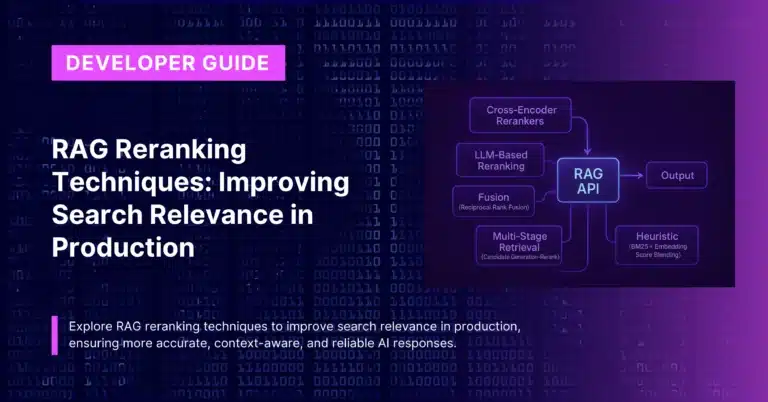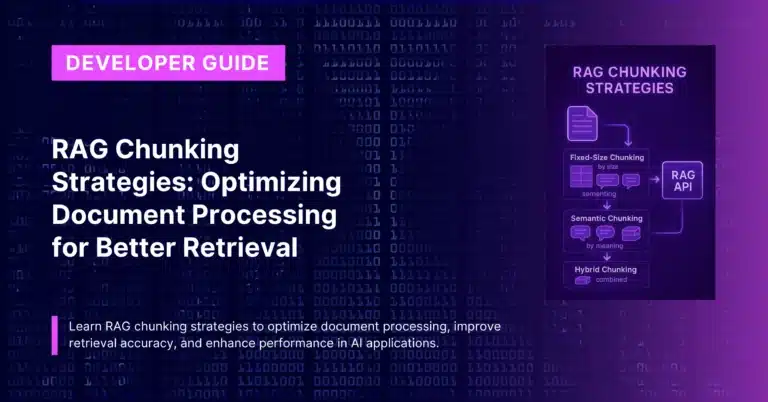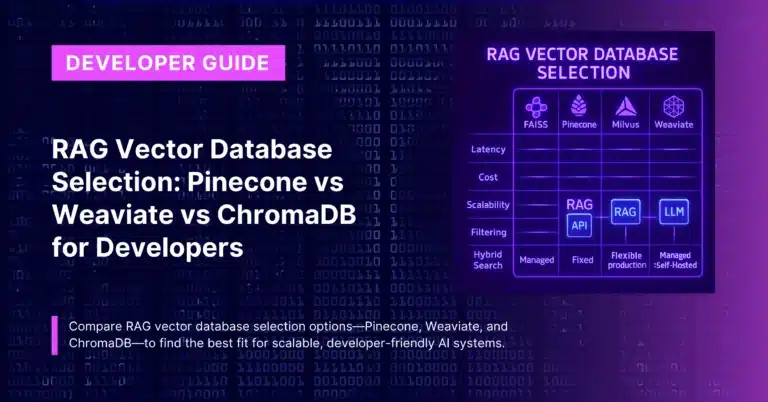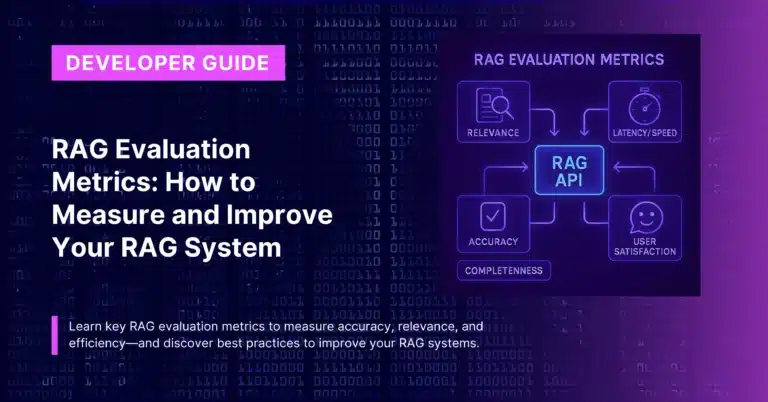
TL;DR
- RAG vs Semantic Search: Semantic Search finds and returns existing documents based on meaning, while RAG retrieves relevant information and generates new, contextual responses.
- Use Semantic Search for document discovery and content retrieval; choose RAG for conversational AI, question-answering systems, and applications requiring synthesized answers from multiple sources.
Many developers entering the AI space encounter similar-sounding technologies—Retrieval-Augmented Generation (RAG) and Semantic Search—and assume they serve the same purpose.
While both involve finding relevant information using advanced natural language processing, they solve fundamentally different problems and serve distinct use cases in modern AI applications.
Understanding these differences is crucial for architects and developers building AI-powered systems.
Choose the wrong approach, and you might build an expensive, overcomplicated solution for simple document retrieval, or a limited search system when users need comprehensive, generated answers.
Core Differences: Retrieval vs. Generation
What is Semantic Search?
Semantic Search goes beyond traditional keyword matching to understand the intent and meaning behind queries. Instead of looking for exact word matches, it:
- Converts queries and documents into vector embeddings using models like OpenAI’s text-embedding-3-small or Cohere’s embeddings
- Performs similarity search in high-dimensional space to find conceptually related content
- Returns relevant documents or passages ranked by semantic relevance
- Presents existing content without modification or synthesis
The output is a ranked list of existing documents, passages, or structured data that best match the user’s intent.
What is RAG (Retrieval-Augmented Generation)?
RAG combines semantic retrieval with generative capabilities to create new responses. The process involves:
- Retrieving relevant documents using semantic search techniques
- Augmenting the user’s query with retrieved context
- Generating synthesized responses using Large Language Models (LLMs)
- Creating original content that combines information from multiple sources
RAG doesn’t just find existing content—it understands, synthesizes, and generates new responses based on retrieved information.
Technical Architecture Comparison
Semantic Search Architecture
A typical semantic search system requires:
Core Components:
- Embedding Model (e.g., sentence-transformers, OpenAI embeddings)
- Vector Database (Pinecone, Weaviate, ChromaDB)
- Similarity Search Algorithm (cosine similarity, dot product)
- Ranking System for result ordering
Implementation Complexity: Low to Medium
Setup Time: 1-2 weeks for production systems
Maintenance Overhead: Low (primarily data updates and index optimization)
Basic Implementation Pattern:
# Simplified semantic search flow
query_embedding = embedding_model.encode(user_query)
similar_docs = vector_db.similarity_search(
query_embedding,
top_k=10
)
return ranked_results(similar_docs)RAG Architecture
RAG systems require all semantic search components plus:
Additional Components:
- Large Language Model (GPT-4, Claude, open-source alternatives)
- Prompt Engineering for context injection
- Response Generation Pipeline with safety filters
- Context Management for conversation history
Implementation Complexity: Medium to High
Setup Time: 3-6 weeks for production systems
Maintenance Overhead: Higher (model updates, prompt optimization, generation quality monitoring)
Basic RAG Pattern:
# Simplified RAG flow
retrieved_docs = semantic_search(user_query)
augmented_prompt = f"""
Context: {retrieved_docs}
Question: {user_query}
Generate a comprehensive answer based on the provided context.
"""
response = llm.generate(augmented_prompt)
return synthesized_responsePerformance and Scalability Considerations
Semantic Search Performance
Advantages:
- Low latency: Single vector similarity search operation
- Predictable costs: Primary expense is vector database operations
- High throughput: Can handle thousands of concurrent queries
- Caching friendly: Results can be cached effectively
Performance Metrics:
- Query response time: 10-100ms
- Scalability: Linear with document corpus size
- Resource requirements: Moderate (mainly vector storage and compute)
RAG Performance
Challenges:
- Higher latency: Retrieval + generation pipeline adds overhead
- Variable costs: LLM API calls can be expensive at scale
- Complex scaling: Multiple system components with different bottlenecks
- Generation variability: Response quality depends on prompt engineering
Performance Metrics:
- Query response time: 500ms-5s depending on LLM
- Scalability: Limited by LLM API rate limits or local model capacity
- Resource requirements: High (vector storage + GPU compute for local models)
Use Case Applications
When to Choose Semantic Search
Ideal Applications:
- Document Management Systems: Help users find relevant PDFs, reports, or policies
- Knowledge Base Search: Retrieve specific articles or FAQ entries
- Product Discovery: E-commerce search and recommendation engines
- Content Recommendation: Suggest related articles, videos, or resources
- Research Tools: Academic paper discovery and literature review
Real-world Example: A company’s internal wiki search system uses semantic search to help employees find relevant documentation. When someone searches “password reset procedure,” the system returns existing how-to guides, security policies, and IT contact information—without generating new content.
Technical Requirements:
- Domain expertise: Information retrieval and vector databases
- Data preparation: Document chunking and embedding generation
- Infrastructure: Vector database and embedding API access
When to Choose RAG
Ideal Applications:
- Conversational AI: Customer support chatbots that synthesize information
- Question-Answering Systems: Generate comprehensive answers from multiple sources
- Research Assistants: Combine information from various documents into coherent responses
- Educational Tools: Create explanations that adapt to user knowledge levels
- Technical Documentation: Generate contextual help based on user queries
Real-world Example: A healthcare AI assistant uses RAG to answer patient questions about medications. When asked “What are the side effects of my blood pressure medication?”, it retrieves information from multiple medical databases, patient records, and drug interaction data, then generates a personalized response considering the patient’s specific medication, medical history, and current conditions.
Technical Requirements:
- Advanced ML expertise: LLM integration and prompt engineering
- Safety considerations: Content filtering and accuracy validation
- Complex infrastructure: Multiple AI services and orchestration
Cost Analysis for Decision Making
Semantic Search Costs
Upfront Costs:
- Vector database setup: $100-1,000 depending on scale
- Embedding model integration: Usually free or low-cost APIs
- Development time: 40-80 hours for production systems
Operational Costs:
- Vector database hosting: $50-500/month based on data volume
- Embedding generation: $0.0001 per document/query
- Minimal compute requirements for similarity search
RAG Implementation Costs
Upfront Costs:
- All semantic search components plus:
- LLM integration and testing: 80-200 hours
- Prompt engineering and optimization: 40-100 hours
- Safety and quality assurance systems: 60-120 hours
Operational Costs:
- Vector database: Same as semantic search
- LLM API calls: $0.01-0.10 per generated response
- Higher infrastructure costs for model hosting (if running locally)
Cost Example: For an application with 10,000 monthly queries:
- Semantic Search: ~$100-200/month
- RAG System: ~$500-2,000/month (depending on LLM usage)
Implementation Guidance and Best Practices
Semantic Search Implementation
Essential Steps:
- Choose embedding models appropriate for your domain (general vs. specialized)
- Design chunking strategy for optimal retrieval granularity
- Select vector database based on scale and performance requirements
- Implement relevance scoring with domain-specific adjustments
- Build user interface for browsing and filtering results
Common Pitfalls to Avoid:
- Using generic embeddings for highly specialized domains
- Poor document chunking leading to irrelevant results
- Ignoring metadata and filtering capabilities
- Insufficient query preprocessing and normalization
RAG Implementation
Essential Steps:
- Implement robust semantic search as the foundation
- Select appropriate LLM balancing cost, accuracy, and latency
- Design prompt templates with clear instructions and examples
- Implement response validation to prevent hallucinations
- Build feedback loops for continuous improvement
Advanced Considerations:
- Context window optimization: Managing token limits across multiple retrieved documents
- Multi-step reasoning: Breaking complex queries into retrievable components
- Source attribution: Ensuring generated responses cite original sources
- Response caching: Reducing costs for repeated queries
Getting Started with Production Systems
For developers ready to implement either approach, consider leveraging existing infrastructure rather than building from scratch:
Semantic Search Solutions:
- Elasticsearch with vector similarity
- Pinecone for managed vector database
- Open-source alternatives like ChromaDB or Weaviate
RAG Platform Options: The CustomGPT platform provides enterprise-grade RAG capabilities with a simple API interface. Their developer starter kit offers a complete implementation with voice features and multiple deployment options, while their RAG API maintains OpenAI compatibility for easy integration.
You can get started immediately by creating an API key at https://app.customgpt.ai and experimenting with their comprehensive documentation and examples.
The Hybrid Approach: When to Combine Both
Many successful AI applications use both semantic search AND RAG in complementary ways:
Common Hybrid Patterns:
- Semantic search for document discovery + RAG for detailed explanations
- Semantic search for FAQ matching + RAG for complex, multi-part questions
- Semantic search for initial filtering + RAG for personalized responses
Implementation Strategy:
- Start with semantic search to validate retrieval quality
- Add RAG capabilities for queries requiring synthesis or personalization
- Use semantic search as a fallback when generation fails or isn’t needed
Migration Considerations
From Semantic Search to RAG
When to Migrate:
- Users frequently ask follow-up questions requiring synthesis
- Simple document retrieval no longer meets user needs
- Competition offers more sophisticated AI-powered responses
Migration Strategy:
- Maintain existing semantic search as the retrieval layer
- Add LLM integration with careful prompt engineering
- A/B test generated vs. retrieved responses
- Gradually expand RAG coverage based on user feedback
From RAG to Semantic Search
When to Simplify:
- Generation costs exceed business value
- Users prefer direct access to source documents
- Response accuracy and latency become problematic
- Regulatory requirements favor explainable, non-generated responses
Frequently Asked Questions
Can RAG work without semantic search?
RAG systems typically rely on some form of retrieval mechanism. While traditional keyword search is possible, semantic search provides much better results by understanding query intent and finding conceptually relevant information even when exact keywords don’t match.
Which approach handles multi-language content better?
Both can handle multi-language content, but implementation differs. Semantic search requires multilingual embedding models (like multilingual-E5 or LASER), while RAG additionally needs multilingual LLMs. RAG has an advantage in translating and synthesizing information across languages.
How do I evaluate the quality of each approach?
For Semantic Search, measure precision, recall, and Mean Reciprocal Rank (MRR) against relevance judgments. For RAG, evaluate both retrieval quality (same metrics) plus generation quality (accuracy, coherence, faithfulness to sources). Consider user satisfaction surveys and task completion rates for both.
What about data privacy and compliance?
Semantic search keeps user queries and documents separate from external services (if using local embeddings). RAG typically sends retrieved content to external LLM APIs, raising privacy concerns. For sensitive data, consider local LLM deployment or on-premises solutions.
Can I implement both with the same infrastructure?
Yes, both approaches share core infrastructure (vector database, embedding models). RAG adds LLM integration on top of semantic search capabilities. Starting with semantic search provides a solid foundation for eventual RAG implementation.
The choice between Semantic Search and RAG depends on whether your users need existing documents returned as-is, or synthesized, conversational responses that combine information from multiple sources. Start with your user requirements, consider technical constraints, and remember that the best solution might involve both approaches working together.
For more RAG API related information:
- CustomGPT.ai’s open-source UI starter kit (custom chat screens, embeddable chat window and floating chatbot on website) with 9 social AI integration bots and its related setup tutorials.
- Find our API sample usage code snippets here.
- Our RAG API’s Postman hosted collection – test the APIs on postman with just 1 click.
- Our Developer API documentation.
- API explainer videos on YouTube and a dev focused playlist.
- Join our bi-weekly developer office hours and our past recordings of the Dev Office Hours.
P.s – Our API endpoints are OpenAI compatible, just replace the API key and endpoint and any OpenAI compatible project works with your RAG data. Find more here.
Wanna try to do something with our Hosted MCPs? Check out the docs for the same.
Priyansh is Developer Relations Advocate who loves technology, writer about them, creates deeply researched content about them.





